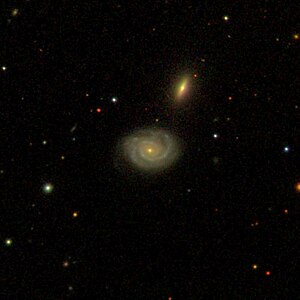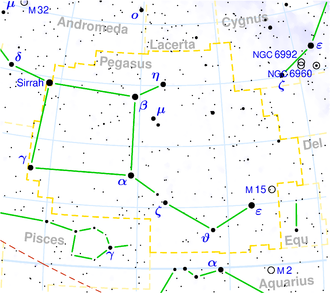NGC 7374
| Galaxy NGC 7374 |
|
|---|---|

|
|
| SDSS recording | |
| AladinLite | |
| Constellation | Pegasus |
|
Position equinox : J2000.0 , epoch : J2000.0 |
|
| Right ascension | 22 h 46 m 00.9 s |
| declination | + 10 ° 51 ′ 13 ″ |
| Appearance | |
| Morphological type | S? |
| Brightness (visual) | 14.0 mag |
| Brightness (B-band) | 14.8 mag |
| Angular expansion | 0.9 ′ × 0.7 ′ |
| Position angle | 93 ° |
| Surface brightness | 13.3 mag / arcmin² |
| Physical data | |
| Redshift | 0.023660 +/- 0.000147 |
| Radial velocity | 7093 +/- 44 km / s |
|
Stroke distance v rad / H 0 |
(325 ± 23) x 10 6 ly (99.5 ± 7.0) Mpc |
| history | |
| discovery | Albert Marth |
| Discovery date | August 7, 1864 |
| Catalog names | |
| NGC 7374 • PGC 69676 • CGCG 430-006 • MCG + 02-58-007 • IRAS 22435 + 1035 • KUG 2243 + 105 • 2MASX J22460094 + 1051130 • LEDA 69676 • LDCE 1534 NED009 | |
NGC 7374 is a spiral galaxy of Hubble type Sbc in the constellation Pegasus at the northern sky . It is estimated to be 325 million light years away from the Milky Way and has a diameter of about 85,000 ly.
In the same area of the sky are the galaxies NGC 7366 , NGC 7370 , NGC 7372 , IC 1452 , among others .
The object was discovered by Albert Marth on August 7, 1864 .
